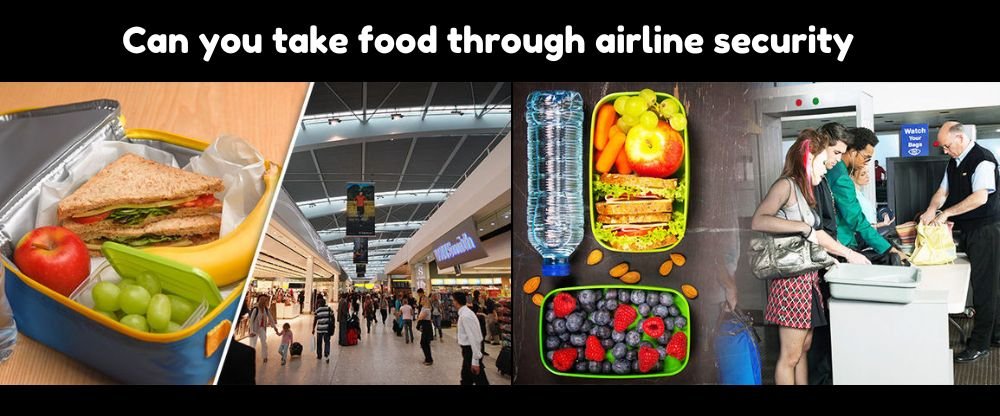As you pack your bags for the upcoming travel, you may wonder about the rules around airport security. Can you take food through airline security? What about that homemade food your parents packed for the trip? Well, the Transportation Security Administration (TSA) that conducts the screening process has some specific guidelines for food and liquid items. Passengers should be aware of these regulations before packing bags or heading to the airport to avoid unwanted hassle. If you’re not sure what to do, don’t worry; we’ll break it down for you.
List Of Allowed & Restricted Items
Practically, the TSA does not completely prohibit any food item, but there are some restrictions on the packed amount. As long as you follow the liquid policy and pack the right quantity, you should be fine. The table below will further help you understand what items you can and cannot bring through TSA security.
| Food Type | Carry-on Bags | Checked Baggage |
| Alcoholic beverages | Allowed (Liquid restrictions apply) | Allowed |
| Alcoholic beverages above 140 proof | Not Allowed | Not Allowed |
| Infant Food | Allowed | Allowed |
| Baby Formula | Allowed under special instructions | Allowed |
| Bottled Water | Allowed under special instructions | Allowed |
| Bread | Allowed | Allowed |
| Breast Milk | Allowed under special instructions | Allowed |
| Candy | Allowed | Allowed |
| Canned Foods | Allowed under special instructions | Allowed |
| Cereal | Allowed | Allowed |
| Cheese | Allowed (Liquid restrictions apply) | Allowed |
| Solid Cheese | Allowed | Allowed |
| Liquid Chocolate | Allowed (Liquid restrictions will apply) | Allowed |
| Chocolate (Solid) | Allowed | Allowed |
| Coffee beans or grounded | Allowed | Allowed |
| Liquid coffee | Allowed (Liquid restrictions will apply) | Allowed |
| Empty coffee thermos | Allowed | Allowed |
| Cooked meat, seafood, and vegetables (excluding liquid) | Allowed | Allowed |
| Cookies | Allowed | Allowed |
| Crackers | Allowed | Allowed |
| Dips and spreads (Creamy) | Allowed (Liquid restrictions apply) | Allowed |
| Dried fruits | Allowed | Allowed |
| Fresh eggs | Allowed | Allowed |
| Fresh fruit and vegetables | Allowed under special instructions | Allowed |
| Fresh meat and seafood | Allowed under special instructions | Allowed |
| Frozen food | Allowed under special instructions | Allowed |
| Gel ice packs | Allowed under special instructions | Allowed |
| Gravy | Allowed (Liquid restrictions apply) | Allowed |
| Gum | Allowed | Allowed |
| Honey | Allowed (Liquid restrictions apply) | Allowed |
| Hummus | Allowed under special instructions | Allowed |
| Ice cream | Allowed (liquid restrictions apply) | Allowed |
| Jam and jelly | Allowed (Liquid restrictions apply) | Allowed |
| Juice for babies | Allowed under special instructions | Allowed |
| Juices | Allowed (Liquid restrictions will apply) | Allowed |
| Live lobster | Consult the specific airline | Allowed |
| Maple Syrups | Allowed (Liquid restrictions will apply) | Allowed |
| Nuts | Allowed | Allowed |
| Oils and Vinegar | Allowed (Liquid restrictions will apply) | Allowed |
| Peanut butter | Allowed (Liquid restrictions will apply) | Allowed |
| Pet food | Allowed | Allowed |
| Pet food (wet) | Allowed (Liquid restrictions will apply) | Allowed |
| Pies and cakes | Allowed | Allowed |
| Pizza | Allowed | Allowed |
| Protein or energy powders | Allowed | Allowed |
| Salad dressing | Allowed (Liquid restrictions will apply) | Allowed |
| Salsa and sauces | Allowed (Liquid restrictions will apply) | Allowed |
| Salt | Allowed | Allowed |
| Sandwiches | Allowed | Allowed |
| Snack bar | Allowed | Allowed |
| Snacks | Allowed | Allowed |
| Soda | Allowed (Liquid restrictions will apply) | Allowed |
| Solid foods | Allowed | Allowed |
| Soups | Allowed (Liquid restrictions will apply) | Allowed |
| Dry Spices | Allowed | Allowed |
| Tamales | Allowed | Allowed |
| Tea, including dry tea bags or loose tea leaves | Allowed | Allowed |
| Water for babies | Allowed under special instructions | Allowed |
| Yogurt | Allowed (Liquid restrictions will apply) | Allowed |
Solid Foods Gets The Green Flag
Among other types of foods, TSA permits almost all solids and non-liquid food through the screening checkpoint without any trouble. This implies that you can think to pack the following food items safely:
- Fresh fruits and vegetables.
- Sandwiches and baked goods.
- Candy, chips, nuts, crackers, etc.
- Frozen meals, such as pizza, burritos, etc.
- Pies and cakes (restriction for liquid and gel-based items may apply)
- Dried foods like beef jerky or self-stable packages.
So, feel free to bring all that extra burrito from Taco Bell or pack up extra protein bars for the flight. Just be mindful that baggage weight restrictions still apply; thus, do not overpack. Plus, avoid packing smelly food out of courtesy for fellow passengers. In correspondence, many airlines do not permit food with a pungent smell, like Durian, on board. In fact, some don’t even allow them in checked bags.
The Constantly Changing 3-1-1 Liquid Rule
Arguably, the most frustrating policy of the TSA is the restriction around carrying liquid, gas, and aerosol-based items. It is popularly known as the 3-1-1 rule, which applies when you take the latter items on board the plane with you.
- The liquid must be 3.4 ounces (100 ml) or less per container.
- If you carry more than one container, pack it in a quart-size reasonable and transparent bag.
- Every passenger is limited to only one such bag.
The rules apply to many common food items and beverages like the ones mentioned in the following list. To avoid having your favorite sauce or beverage tossed, check the size restriction carefully.
- Water, juice, and other drinks.
- Peanut butter, cheese spreads, and other pastes.
- Sauce, dips, jams, hummus, salsa, and other condiments(semi-solids).
Exceptions:
This policy has a handful of exceptions, like breast milk or infant food items. Otherwise, these guidelines are strictly enforced.
Conditions For Home-Cooked Meals!
While carrying solid food items is generally fine, there are some extra considerations for bringing home-cooked dishes and leftovers. Check the below-stated points for to present TSA security screening hassles:
- Choosing to pack fully cooked meals reduced the concerns about airport security.
- Other homecooked items like meat, rice, and vegetables. Ensure to thoroughly cool it down before packing.
- Consider packing food ingredients separately to reduce the chances of security alarms.
- Remove any liquid or gel item, such as gravy or curry paste, and pack it according to the 3-1-1 rule.
For an extra layer of security, TSA recommends passengers pack such home-cooked meals in a clear container for easier visual inspection. Keep in mind that if an agent feels the need to inspect further, they completely unwrap the food or transfer it to a separate bin.
Special Consideration For Selected Food Items
There are special rules and inspections required for certain types of food deemed higher risk at the security. When traveling with such items, it’s best to inquire with the specific airport about any additional screening procedure or paperwork required. Being informed ahead of time prevents unnecessary delays or confiscation. The list includes:
- Live Seafood and Fish – Pack it properly with cooling equipment and ensure to declare it at the security as well.
- Fresh Meat, Poultry, and Eggs – Be ready for additional screening if you pack such items for the trip.
- Foreign Canned Goods: They should have factory labels that TSA officials can authorize at the checkpoint.
- Alcohol above 24%: Alcoholic drinks over 48 AVB (alcohol by volume) are subject to liquids rules and duties restrictions.
Bringing Food into the U.S.
When traveling internationally, even between the U.S., Canada, and Mexico, make sure to declare food to the Customs and Border Protection (CBP) agent upon arrival. Restrictions prevent transporting prohibited agricultural items like mats, fresh products, seeds, or other items. This also stops plant pests and animal diseases from entering the country. Therefore, some food will require extra inspection or clarification.
The CBP has a clear guide on clearing food through customs, including the typical products that are allowed to be prohibited in certain countries. Be sure to double-check these rules and regulations before bringing food along on international flights.
In Closing!
While some of the food guidelines for the airport can be confusing, for the most part, packing finger foods and solid items ensures a smooth experience at the TSA checkpoint. Remember the liquid restriction, declare any riskier seafood items, and consult customs policies for international travel. With a little advance planning, you can easily satisfy those travel munchies while complying with all the important protocols. Bon Appetit!
Find Out More:
Yes. Passengers can take food through airport security. Opt for packing fully-cooked items to avoid hassle at the checkpoint.
Technically, there is no prohibition on food as long as you pack according to the liquid restrictions and other regulations.
TSA mostly approves solid food in both checked and carry-on baggage without any restrictions.
Yes, you can bring an open bag of chips through the TSA security screening at the airport.
Yes. It should comply with the 3-1-1 rule, and alcoholic beverages should be below 140 proof for a green pass.
Most solid food and liquid beverages are allowed in carry-on bags. However, passengers must comply with the restrictions.
Yes. Liquid instructions will apply if you are carrying it on board. Otherwise, no limit is applicable.
There is no limit, but passengers must clarify this with the airline of interest.
Yes. Toothpaste has a paste-like consistency; thus, the liquid restriction will apply.
This rule applies to liquid/ gel/ aerosol items packed inside carry-on bags: 3.4 ounces or less liquid packed in 1 quart-sized bag and 1 bag per person.

